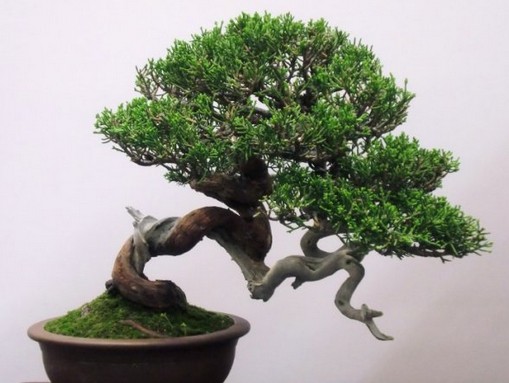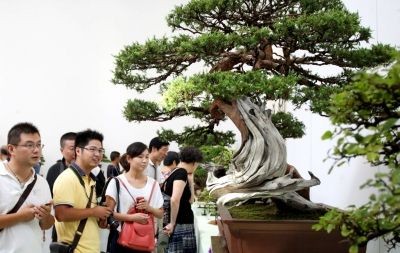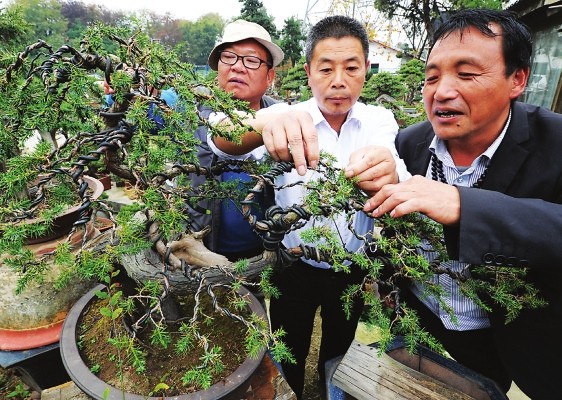Selection of Su-style bonsai tree species and their modeling techniques
Su-style bonsai is one of the five major schools of Chinese bonsai, which consists of two parts: tree stump bonsai and water-stone bonsai. The most common varieties of stump bonsai are pine and cypress, sparrow plum, elm, yellow poplar, triangular maple, crape myrtle, pomegranate, ginkgo and so on. The stone species of water stone bonsai are axe split stone, yellow stone, quartz stone, stalactite, sand stone, thousand-layer stone, tortoise stone and so on. According to its form of expression, tree stump bonsai can be divided into single dry type, double dry type, jungle type, cliff type, horizontal dry type, oblique dry type, etc., and can be divided into co-planted bonsai, single bonsai and tree stone bonsai according to its cultivation form.

I. selection of tree species for bonsai
The main theme of Suzhou bonsai is trees, and local tree species are generally selected.
Second, unique modeling skills
Suzhou as the center, including Changshu area, spread in the south of the Yangtze River, and played a certain role in the bonsai of Shanghai and Zhejiang. Suzhou is a famous historical and cultural city in China. It is located in the lower reaches of the Yangtze River and in the waters of Taihu Lake. It is a land of fish and rice in the south of the Yangtze River. Su style bonsai originated from the prosperous Tang Dynasty, flourished in the Song Dynasty, and flourished in the Ming and Qing dynasties. Bai Juyi in the Tang Dynasty, Fan Chengda in the Song Dynasty, Wen Zhenheng in the Ming Dynasty, Hu Huanzhang in the Qing Dynasty, Zhou Lianjuan and Zhu Zian in modern times all contributed to the bonsai art of the Su School.
The traditional Su style bonsai modeling is also mostly regular. The cultivation method is from the beginning of the seedling modeling, but the growth rate is slow, it takes a long time to form, and produces the same phenomenon.
Modern Suzhou bonsai, advocated by bonsai expert Zhou Lianjuan and artist Zhu Zian, regards nature as beauty, absorbs the essence of Suzhou bonsai in the Ming and Qing dynasties, pays attention to learning from nature, pays attention to poetic painting, and gradually forms the modeling techniques of "rough and fine cut, cut and use", "mainly cut, supplemented by tie", forming the elegant and elegant artistic features of Suzhou bonsai.
The whole production process of Suzhou stump bonsai can be roughly divided into the steps of pile selection, excavation, shaping, blank cultivation, pot planting, bud selection, maintenance, climbing, pruning, film maintenance, basin turning and so on. In the technique, "to tie as a supplement, mainly to cut, coarse and fine cut, cut and use". Among them, pile selection, climbing and pruning are the key to stump modeling, and they are also the unique modeling skills of Su-style bonsai, which are different from other major schools. (1) selection of piles
There are two sources of materials for Suzhou stump bonsai: wild excavation and artificial propagation. Because the wild excavation has the following advantages: beautiful natural posture, fast forming and low cost, this method is basically adopted now. Wild excavation stump mainly includes the following steps: pre-preparation, excavation time, mining methods, packaging and transportation and so on.
Time: 2019-06-04 Click:
- Prev

Su style Bonsai-- the Art of carving with time
Bonsai is a literati art, which has a deep folk foundation in Suzhou. In Suzhou during the Ming and Qing dynasties, dignitaries built gardens, while ordinary people played bonsai. Bonsai is also an art carved with time. Despite its small size, it takes more than ten years from potted cultivation to production.
- Next

The climbing technique of Su Pai Bonsai
Suzhou bonsai is traditionally climbing with brown silk, which has the advantage of harmonious color between brown silk and bark, and the ornamental value of pile scenery after climbing is higher. However, the climbing of brown silk is more difficult, and the skill of climbing can be seen. The main link is to master the focal point of brown climbing and the thickness of brown silk should be appropriate.
Related
- Fuxing push coffee new agricultural production and marketing class: lack of small-scale processing plants
- Jujube rice field leisure farm deep ploughing Yilan for five years to create a space for organic food and play
- Nongyu Farm-A trial of organic papaya for brave women with advanced technology
- Four points for attention in the prevention and control of diseases and insect pests of edible fungi
- How to add nutrient solution to Edible Fungi
- Is there any good way to control edible fungus mites?
- Open Inoculation Technology of Edible Fungi
- Is there any clever way to use fertilizer for edible fungus in winter?
- What agents are used to kill the pathogens of edible fungi in the mushroom shed?
- Rapid drying of Edible Fungi

